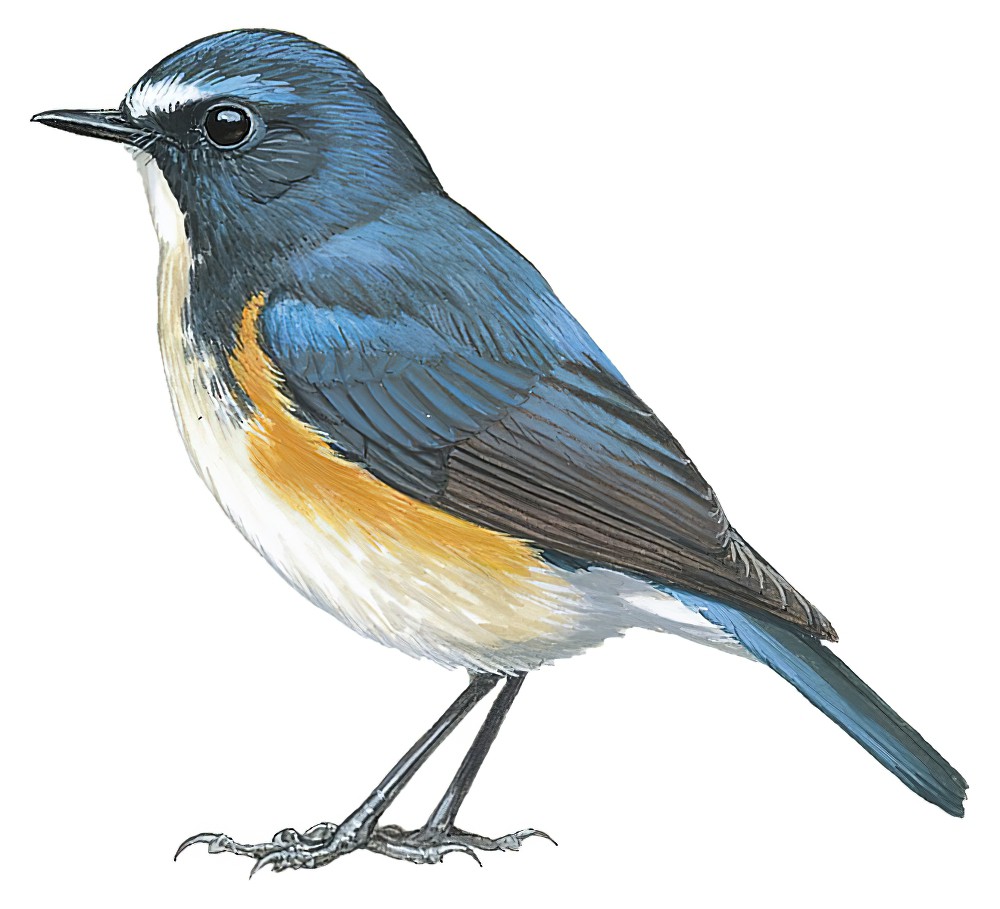Red-flanked Bluetail / Tarsiger cyanurus

Red-flanked Bluetail
SCI Name:
Protonym: Motacilla Cyanurus ReiseVersch.Provin.Russ.Reichs 2 p.664,690,709
Taxonomy: Passeriformes / Muscicapidae / Tarsiger
Taxonomy Code: refblu
Type Locality: Yenisei.
Author: Pallas
Publish Year: 1773
IUCN Status: Least Concern
DEFINITIONS
TARSIGER
(Muscicapidae; Ϯ Golden Bush Robin T. chrysaeus) Mod. L. tarsus leg, shank < Gr. ταρσος tarsos flat of the foot; L. -ger bearing < gerere to carry; "Luscinidæ. ... Tarsiger chrysæus, [drawing nos.] 408, 409." (Hodgson 1844); “Genus Tarsiger, mihi. Bill equal to head, straight, subdepressed, feeble, gradually widening from the tip; the upper mandible more than half exceeded by the nareal fosse, and much overlaid by the soft frontal plumes; tip of bill obtuse, and nearly unarmed; gape rather wide and ciliated; wings submedial, round rather than acuminate, firm; fifth quill longest; 4-6 and 3-7 respectively equal; alars and caudals wedged and mucronate; tail medial, rounded; tarse very elevate, slender and smooth; toes ambulant, simple; laterals unequal, hinder rather large; nails large, slender, simple; hind largest. Exclusively monticolous; dwells in low brushwood solitarily, and is much on the ground, feeding chiefly on small ground insects. ... Type, T. chrysæus, mihi” (Hodgson 1845); "Tarsiger Hodgson, 1845, Proc. Zool. Soc. London, p. 28, ex Hodgson, in Gray, 1844, Zool. Misc., p. 83, nom. nud. Type, by monotypy [= original designation], Tarsiger chrysaeus Hodgson." (Ripley in Peters 1964, X, 33).
Synon. Dorisella, Ianthia, Nemura.
cyanurus
Gr. κυανος kuanos dark-blue; -ουρος -ouros -tailed < ουρα oura tail.
● ex “Blue fork-tailed Humming-bird” of Latham 1822 (syn. Aglaiocercus kingi).
● ex “Blue-rumped Parrakeet” of Latham 1787 (Psittinus).
● ex “Héoro-taire bleu” of Audebert & Vieillot 1802 (?syn. Zosterops lateralis).
● ex “Avis yayauquitototl” of Seba 1734-1754, “Polytmus mexicanus longicaudus” of Brisson 1760, “Brin bleu” of de Buffon 1770-1783, and “Blue-tailed Humming-bird” of Latham 1782 (unident.).
Cyanurus
Gr. κυανος kuanos dark-blue; ουρα oura tail.
• (Corvidae; syn. Cyanocorax † White-throated Magpie Jay C. formosus) "817. Cyanurus, Bp. ex Sw. (Cyanocorax, p. Boie. - Calocitta hinc Psilorhinus, p. Gr.) Rostrum nigrum: cauda longissima. Am. s. As. or. 4. a. Americani. 1. PICA bullocki, Wagl. 1827. (miles, Licht. - formosa, Sw. 1827. - gubernatrix, Temm. - Psilorhinus gubernatrix, Gr.) Pl. col. 436. ex Mexico or. Vera-Cruz. ... 2. PICA colliei, Vig. (Garrulus ultramarinus, Aud. nec Bp. G. bullocki, Aud. nec Wagl. - G. burneti, errore burnetti, berneti et bennetti, J. Gr. - Psilorhinus bullocki, Gr.) Zool. Beach. Voy. t. 7. - Aud. Am. t. 96. - Quarto edit. t. 229. ex Mexico occ. California." (Bonaparte 1850); "Cyanurus (not of Swainson, 1832) Bonaparte, Consp. Gen. Av., 1, p. 380, 1850—type, by subs. desig. (Sharpe, Cat. Bds. Brit. Mus., 3, p. 88, 1877), Pica formosa Swainson." (Hellmayr, 1934, Cat. Birds Americas, Pt. VII, p. 11).
• (Corvidae; syn. Cyanocorax † Plush-crested Jay C. chrysops) "Genus, CYANURUS. ... Examples. - 1. C. cristatus. 2. Stelleri. 3. sordidus, Sw. 4. Floridanus, BON. 5. coronatus, Sw. Syn. 6. cyanopogon (Pl. col. 169). 7. pileatus (Ill. 58). 8. azureus (Ill. 168) 9. formosus (Pica formosa, Sw. Syn.) 10. cristatellus (Pl. col. 193), &c. OBS. - This group is distinguished from the European and North Asiatic Jays by the upper mandible not being abruptly bent at the tip, or very distinctly notched, by the under being weaker, and by the powerful structure of the feet. The two outer toes also are almost equal. The first three species are aberrant, connecting this and the last group [Dysornithia]. The typical species are found only in the tropics of America and India" (Swainson 1832); "The genera Psilorhinus and Cissa, with Cyanocorax of South America, form a little group by themselves; and I consider that Mr. Strickland was quite justified in separating from the last the blue Jays of North America, which constitute his Cyanocitta, An. and Mag. Nat. Hist. 1845, p. 260; but as Corvus cristatus, Lin. is the type of Mr. Swainson's Cyanurus, I conceive that this must take precedence of Cyanocitta, Strickland" (Blyth 1846); "The type of the genus Cyanocitta of Strickland is Garrulus cristatus, Linn. as stated in precise terms by the founder of the genus ... Again, the type of Cyanurus, Sw., is not Garrulus cristatus ... This error was caused by Mr. G. R. Gray's [1855] unauthorized assumption that the first species in any author's list must necessarily be his type. But Swainson himself tells us that the first three species which he mentions (i.e. C. cristatus, C. stelleri, and C. sordidus) are "aberrant," and that the "typical" species are only found in the "tropics of America and India." It is obvious therefore that Cyanurus, Sw. (1831) = Cyanocorax, Boie (1826) as stated by Strickland l.s.c., and that Cyanocitta is the proper generic name for the "Blue Jays" of America" (P. Sclater & Salvin 1876); "Cyanurus Swainson, in Richardson, Faun. Bor.-Amer., 2, p. 495, Feb., 1832— no type designated. 2 ... 2 No valid type appears to have been designated for this genus. ... Though, by common consent, Cyanurus has been regarded as synonymous with Cyanocorax, it seems advisable to formally propose a genotype to set this name at rest, and we suggest as such Corvus pileatus "Ill." = Pica chrysops Vieillot." (Hellmayr, 1934, Cat. Birds Americas, Pt. VII, p. 17).
UPPERCASE: current genus
Uppercase first letter: generic synonym
● and ● See: generic homonyms
lowercase: species and subspecies
●: early names, variants, mispellings
‡: extinct
†: type species
Gr.: ancient Greek
L.: Latin
<: derived from
syn: synonym of
/: separates historical and modern geographic names
ex: based on
TL: type locality
OD: original diagnosis (genus) or original description (species)












